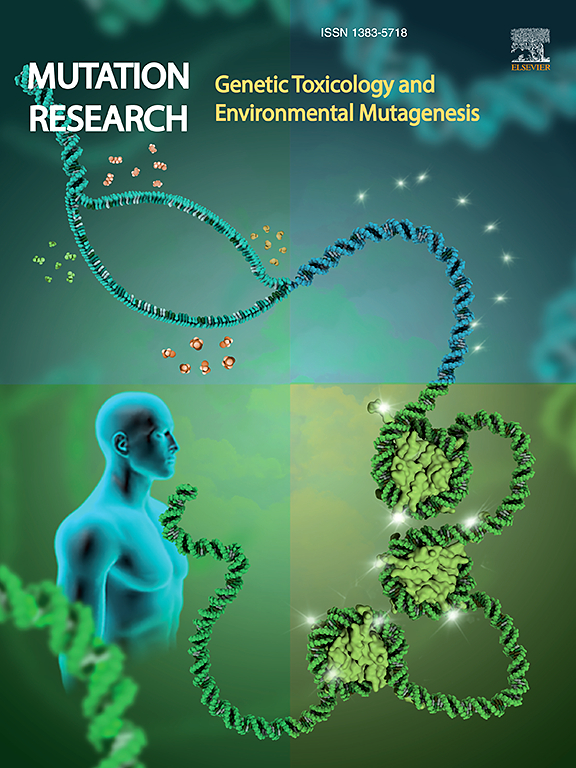Photogenotoxicity of N-nitrosoproline plus simultaneous UVA irradiation in human-derived keratinocytes
IF 2.5
4区 医学
Q3 BIOTECHNOLOGY & APPLIED MICROBIOLOGY
Mutation research. Genetic toxicology and environmental mutagenesis
Pub Date : 2025-07-01
DOI:10.1016/j.mrgentox.2025.503876
引用次数: 0
Abstract
In this study, we investigated the genotoxicity of N-nitrosoproline (NPRO) in human-derived keratinocytes (HaCaT and NCTC2544 cells) using simultaneous UVA irradiation without metabolic activation. NPRO plus UVA exhibited dose- and intensity-dependent micronuclei formation in the keratinocytes, as well as nitric oxide (NO) production. The action spectra of genotoxicity and NO formation from NPRO plus UVA followed the absorption curve of NPRO, indicating that photoenergy was absorbed by the NPRO-triggered photoreaction. A significant increase in cyclic guanosine monophosphate (cGMP) was observed in HaCaT cells treated with NPRO plus UVA. NO production from UVA-irradiated NPRO paralleled micronuclei formation, and the phototoxicity of NPRO may have simultaneously interfered with the cGMP-related signaling systems caused by NO from photoactivated NPRO.
n-亚硝基脯氨酸加同时UVA照射对人源性角质形成细胞的光毒性
在这项研究中,我们研究了n-亚硝基脯氨酸(NPRO)在无代谢激活的同时UVA照射下对人源性角质形成细胞(HaCaT和NCTC2544细胞)的遗传毒性。NPRO加UVA在角质形成细胞中表现出剂量和强度依赖的微核形成,以及一氧化氮(NO)的产生。NPRO + UVA的遗传毒性和生成NO的作用谱符合NPRO的吸收曲线,说明NPRO触发的光反应吸收了光能。在NPRO加UVA处理的HaCaT细胞中,cGMP显著增加。uva辐照NPRO产生的NO与微核形成平行,NPRO的光毒性可能同时干扰了NPRO光活化NO引起的cgmp相关信号系统。
本文章由计算机程序翻译,如有差异,请以英文原文为准。
求助全文
约1分钟内获得全文
求助全文
来源期刊
CiteScore
3.80
自引率
5.30%
发文量
84
审稿时长
105 days
期刊介绍:
Mutation Research - Genetic Toxicology and Environmental Mutagenesis (MRGTEM) publishes papers advancing knowledge in the field of genetic toxicology. Papers are welcomed in the following areas:
New developments in genotoxicity testing of chemical agents (e.g. improvements in methodology of assay systems and interpretation of results).
Alternatives to and refinement of the use of animals in genotoxicity testing.
Nano-genotoxicology, the study of genotoxicity hazards and risks related to novel man-made nanomaterials.
Studies of epigenetic changes in relation to genotoxic effects.
The use of structure-activity relationships in predicting genotoxic effects.
The isolation and chemical characterization of novel environmental mutagens.
The measurement of genotoxic effects in human populations, when accompanied by quantitative measurements of environmental or occupational exposures.
The application of novel technologies for assessing the hazard and risks associated with genotoxic substances (e.g. OMICS or other high-throughput approaches to genotoxicity testing).
MRGTEM is now accepting submissions for a new section of the journal: Current Topics in Genotoxicity Testing, that will be dedicated to the discussion of current issues relating to design, interpretation and strategic use of genotoxicity tests. This section is envisaged to include discussions relating to the development of new international testing guidelines, but also to wider topics in the field. The evaluation of contrasting or opposing viewpoints is welcomed as long as the presentation is in accordance with the journal''s aims, scope, and policies.

 求助内容:
求助内容: 应助结果提醒方式:
应助结果提醒方式:


